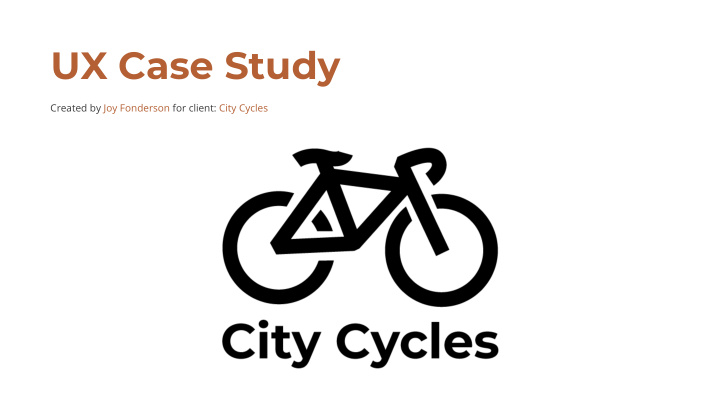



UX Case Study Created by Joy Fonderson for client: City Cycles
Introduction As part of my Skillcrush UX class, I was tasked with: improving the user experience of an existing web app for a client named City Cycles. The City Cycles site lets users rent bikes, similar to ordering a Zipcar or Uber ride, with the ultimate goal of letting people enjoy the city from a fresh perspective. City Cycles discovered their bike reservation process was inefficient, requiring users to come by the office and complete paperwork in-person before being allowed to confirm their booking. This led to fewer bike rentals and an increase in customer phone traffic. I was hired to improve the site’s UX, making the online rental process easier and more convenient for bikers, thus increasing the number of online bike rentals.
The Problem The client’s existing website looked like this: Users were complaining that the site was “frustrating” to use and they felt “misled.”
My UX Role in This Project I was tasked with: improving the user experience (UX) of the existing City Cycles website. Throughout this UX project, my job included completing the following tasks: 1. Ideating solutions for the users’ problem or pain point 2. Deciding the scope of the project 3. Interviewing users 4. Making wireframes 5. Sketching out a prototype 6. Building a prototype 7. Testing it with users 8. Making recommendations on the next steps
My Approach My approach to this UX project started with taking the following steps: 1. Empathising with the user and ensuring my designs hinged on what would be best for them 2. Looking at what could be changed and assessing what to prioritise 3. Making changes and then checking back with users to confirm my hypothesis with data
Key Findings After performing research, collecting data, and analyzing the results, this is what I found: The site confusing and annoying - Users keep coming back to the logo, the menu and the search bar to try & find what they are looking for. Knowing this, users prefer to call or drop by to make their booking and bypass the site completely - ¾ of users never return to the site after a 1st visit.
Solutions After ideating some potential solutions to the users’ problems and pain points, I decided to move forward with the following idea: Re-design the menu so it includes a clear “Book Now” button that would lead users through a short 3 click reservation process with instant confirmation. This would address the confusion issue and the annoyance of needing to phone or take a trip down to the office for a booking confirmation and increase the online reservation rate by 50%. Hand-drawn paper prototype of my initial solution idea
Solutions Based off my paper prototype, I created a high-fidelity, interactive digital prototype of my proposed solution. After performing a usability test on my prototype, I received the following feedback: The site is much more logical and the reservation is button and process are much easier to find. Based upon the results of my usability test, I proposed the following next step(s): Changing the main navigation to make finding the desired information clearer and I made the booking process front and centre on the front page so users could reserve a bike easily without getting frustrated by endless browsing. I also suggested adjusting the text and search box colours so they would be easier to read and find. These combined changes resolve the confusion and frustration pain points users described and the client’s concern about users not using the site as expected. InVision prototype screenshot
LESSONS LEARNED The biggest challenge or obstacle I faced during this UX project was: Not to run with my assumptions and personal biases but rely solely on the research date to build the project so the project would remain user-centred at each step of the creation process. The lessons I learned from this UX project included: The importance to advocating for the users ● Accepting the importance of collaboration and knowing when ● to compromise How to present high level takeaways to stakeholders ●
Recommend
More recommend